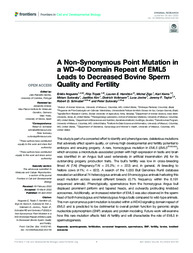A Non-synonymous point mutation in a WD-40 domain repeat of EML5 leads to decreased bovine sperm quality and fertility.
A Non-synonymous point mutation in a WD-40 domain repeat of EML5 leads to decreased bovine sperm quality and fertility.
Author(s): NOGUEIRA, E.; TIRPÁK, F.; HAMILTON, L.; ZIGO, M.; KERNS, K.; SUTOVSKY, M.; KIM, J.; VOLKMANN, D.; JOVINE, L.; TAYLOR, J. F.; SCHNABEL, R. D.; SUTOVSKY, P.
Summary: This study is part of a concerted effort to identify and phenotype rare, deleterious mutations that adversely affect sperm quality, or convey high developmental and fertility potential to embryos and ensuing progeny. A rare, homozygous mutation in EML5 (EML5R1654W), which encodes a microtubule-associated protein with high expression in testis and brain was identified in an Angus bull used extensively in artificial insemination (AI) for its outstanding progeny production traits. The bull?s fertility was low in cross-breeding timed AI (TAI) (Pregnancy/TAI = 25.2%; n = 222) and, in general, AI breeding to Nellore cows (41%; n = 822). A search of the 1,000 Bull Genomes Run9 database revealed an additional 74 heterozygous animals and 8 homozygous animals harboring this exact mutation across several different breeds (0.7% frequency within the 6,191 sequenced animals). Phenotypically, spermatozoa from the homozygous Angus bull displayed prominent piriform and tapered heads, and outwardly protruding knobbed acrosomes. Additionally, an increased retention of EML5 was also observed in the sperm head of both homozygous and heterozygous Angus bulls compared to wild-type animals. This non-synonymous point mutation is located within a WD40 signaling domain repeat of EML5 and is predicted to be detrimental to overall protein function by genomic single nucleotide polymorphism (SNP) analysis and protein modeling. Future work will examine how this rare mutation affects field AI fertility and will characterize the role of EML5 in spermatogenesis.
Publication year: 2022
Types of publication: Journal article
Unit: Embrapa Pantanal
Observation
Some of Embrapa's publications are published as ePub files. To read them, use or download one of the following free software options to your computer or mobile device. Android: Google Play Books; IOS: iBooks; Windows and Linux: Calibre.
Access other publications
Access the Agricultural Research Database (BDPA) to consult Embrapa's full library collection and records.
Visit Embrapa Bookstore to purchase books and other publications sold by Embrapa.

